Citroen JUMPY 2016 2.G Owner's Manual
Manufacturer: CITROEN, Model Year: 2016, Model line: JUMPY, Model: Citroen JUMPY 2016 2.GPages: 595, PDF Size: 12.47 MB
Page 331 of 595

329
Jumpy _en_Chap09_caracteristiques-techniques_ed01-2016
* With moduwork, flap removed.
C o m p a c t ( L1)
Standard (L2)
Long (L3)
9
Technical data
Page 332 of 595

330
Jumpy _en_Chap09_caracteristiques-techniques_ed01-2016
Mirrors folded
Side-hinged doors TailgateC o m p a c t ( L1)
Standard (L2)
Long (L3)
* Increased payload.
** Payload increased with high body.
*** Depending on the country of sale.
Technical data
Page 333 of 595

331
Jumpy _en_Chap09_caracteristiques-techniques_ed01-2016
Platform cab
9
Technical data
Page 334 of 595
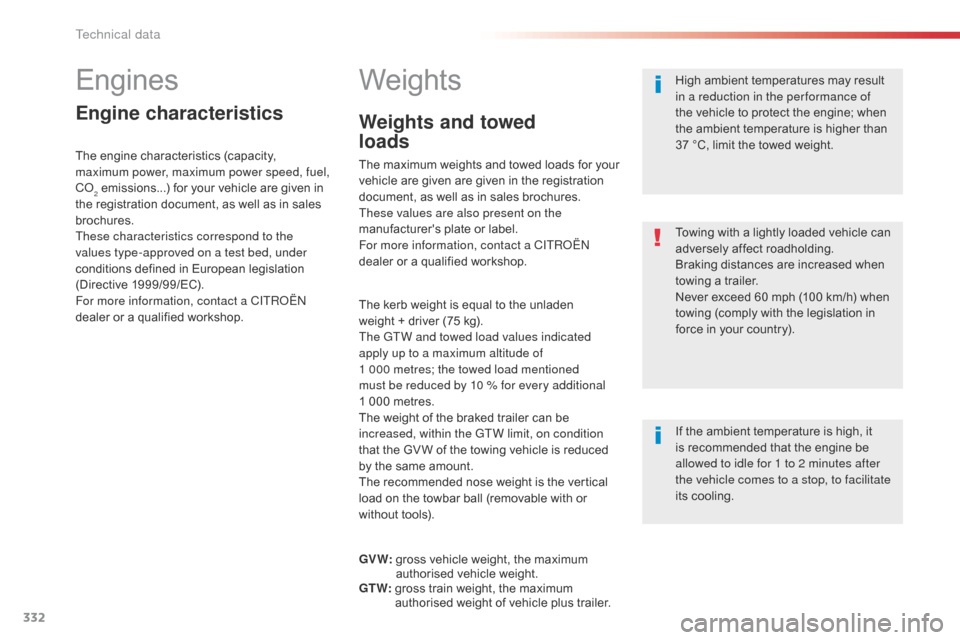
332
Jumpy _en_Chap09_caracteristiques-techniques_ed01-2016
Engines
Engine characteristics
The engine characteristics (capacity,
maximum power, maximum power speed, fuel,
CO
2 emissions...) for your vehicle are given in
t
he registration document, as well as in sales
brochures.
These characteristics correspond to the
values type-approved on a test bed, under
conditions defined in European legislation
(Directive
1
999/99/EC).
For more information, contact a CITROËN
dealer or a qualified workshop.
Weights
The kerb weight is equal to the unladen
weight + driver (75 kg).
The GTW and towed load values indicated
apply up to a maximum altitude of
1
000 metres; the towed load mentioned
must be reduced by 10 % for every additional
1
000 metres.
The weight of the braked trailer can be
increased, within the GTW limit, on condition
that the GV W of the towing vehicle is reduced
by the same amount.
The recommended nose weight is the vertical
load on the towbar ball (removable with or
without tools). High ambient temperatures may result
in a reduction in the per formance of
the vehicle to protect the engine; when
the ambient temperature is higher than
37
°C, limit the towed weight.
If the ambient temperature is high, it
is recommended that the engine be
allowed to idle for 1 to 2 minutes after
the vehicle comes to a stop, to facilitate
its cooling. Towing with a lightly loaded vehicle can
adversely affect roadholding.
Braking distances are increased when
towing a trailer.
Never exceed 60 mph (100 km/h) when
towing (comply with the legislation in
force in your country).
GV W:
g
ross vehicle weight, the maximum
authorised vehicle weight.
GT W:
g
ross train weight, the maximum
authorised weight of vehicle plus trailer.
Weights and towed
loads
The maximum weights and towed loads for your
vehicle are given are given in the registration
document, as well as in sales brochures.
These values are also present on the
manufacturer's plate or label.
For more information, contact a CITROËN
dealer or a qualified workshop.
Technical data
Page 335 of 595
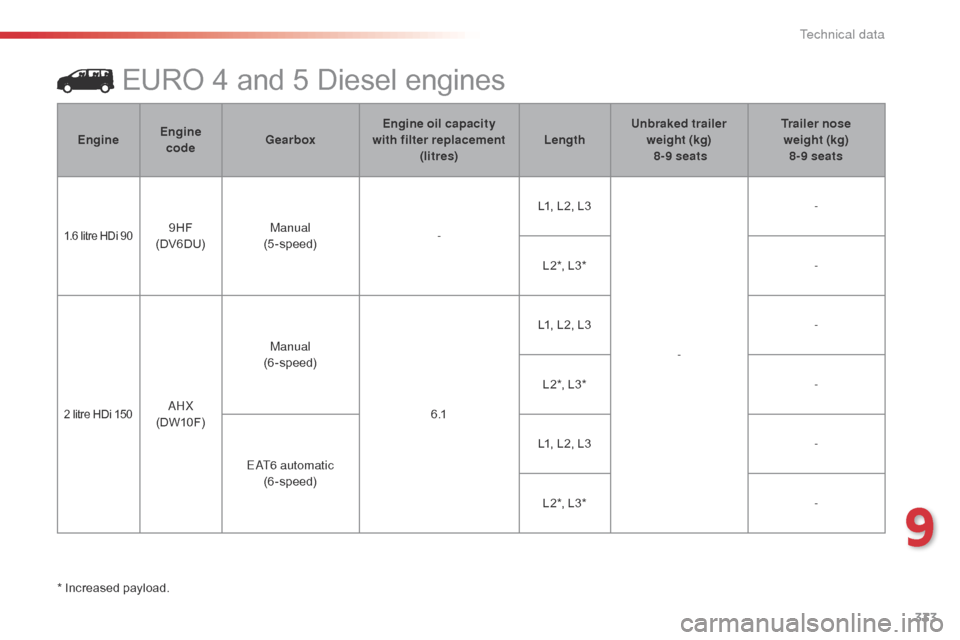
333
Jumpy _en_Chap09_caracteristiques-techniques_ed01-2016
EURO 4 and 5 Diesel engines
* Increased payload.En gine
Engine
code Gearbox Engine oil capacity
with filter replacement (litres) LengthUnbraked trailer
weight (kg)
8-9 seats Trailer nose
weight (kg)
8-9 seats
1.6 litre HDi 909HF
(DV6DU) Manual
(5-speed) -L1, L2, L3
--
L2*, L3* -
2 litre HDi 150AHX
(DW10F) Manual
(6-speed)
6 .1L1, L2, L3
-
L2*, L3* -
EAT6 automatic (6-speed) L1, L2, L3
-
L2*, L3* -
9
Technical data
Page 336 of 595
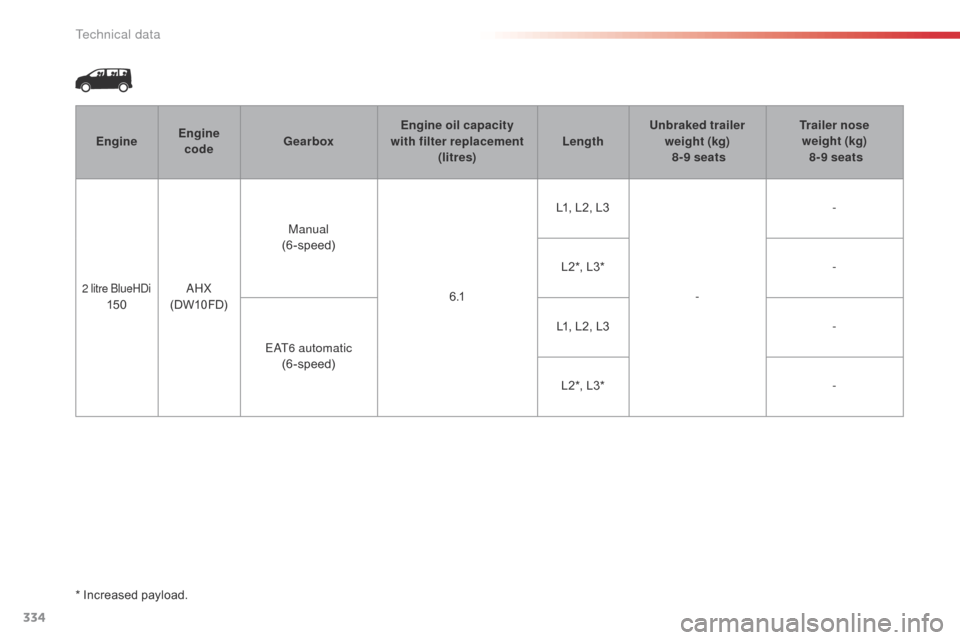
334
Jumpy _en_Chap09_caracteristiques-techniques_ed01-2016
EngineEngine
code Gearbox Engine oil capacity
with filter replacement (litres) LengthUnbraked trailer
weight (kg)
8-9 seats Trailer nose
weight (kg)
8-9 seats
2 litre BlueHDi 150 AHX
(DW10FD) Manual
(6-speed)
6 .1L1, L2, L3
--
L2*, L3* -
EAT6 automatic (6-speed) L1, L2, L3
-
L2*, L3* -
*
Increased payload.
Technical data
Page 337 of 595
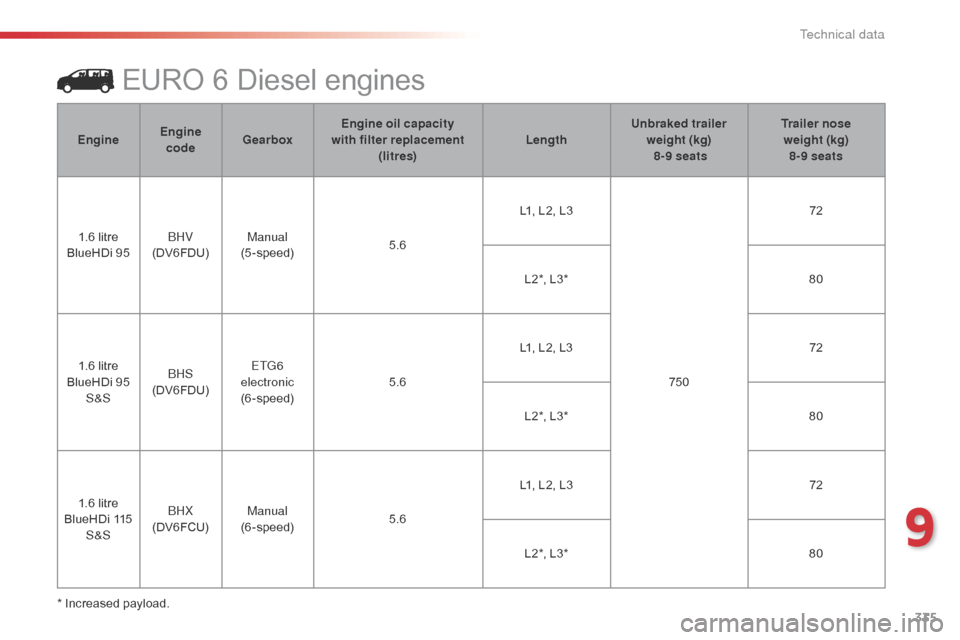
335
Jumpy _en_Chap09_caracteristiques-techniques_ed01-2016
EURO 6 Diesel engines
* Increased payload.En gine
Engine
code Gearbox Engine oil capacity
with filter replacement (litres) LengthUnbraked trailer
weight (kg)
8-9 seats Trailer nose
weight (kg)
8-9 seats
1.6 litre
BlueHDi 95 BHV
(DV6FDU) Manual
(5-speed) 5.6L1, L2, L3
75072
L2*, L3* 80
1.6 litre
BlueHDi 95 S&S BHS
(DV6FDU) ETG6
electronic (6-speed) 5.6L1, L2, L3
72
L2*, L3* 80
1.6 litre
BlueHDi 115 S&S BHX
(DV6FCU) Manual
(6-speed) 5.6L1, L2, L3
72
L2*, L3* 80
9
Technical data
Page 338 of 595
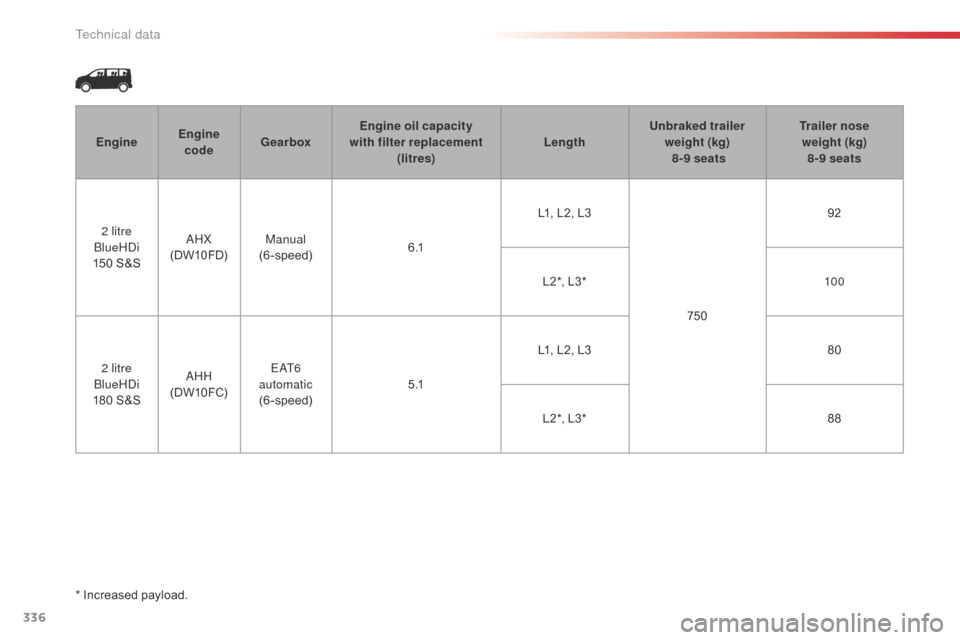
336
Jumpy _en_Chap09_caracteristiques-techniques_ed01-2016
* Increased payload.En gine
Engine
code Gearbox Engine oil capacity
with filter replacement (litres) LengthUnbraked trailer
weight (kg)
8-9 seats Trailer nose
weight (kg)
8-9 seats
2 litre
BlueHDi
150 S&S AHX
(DW10FD) Manual
(6-speed) 6 .1L1, L2, L3
75092
L2*, L3* 10 0
2 litre
BlueHDi
180 S&S AHH
(DW10 FC) E AT 6
automatic (6-speed) 5 .1L1, L2, L3
80
L2*, L3* 88
Technical data
Page 339 of 595
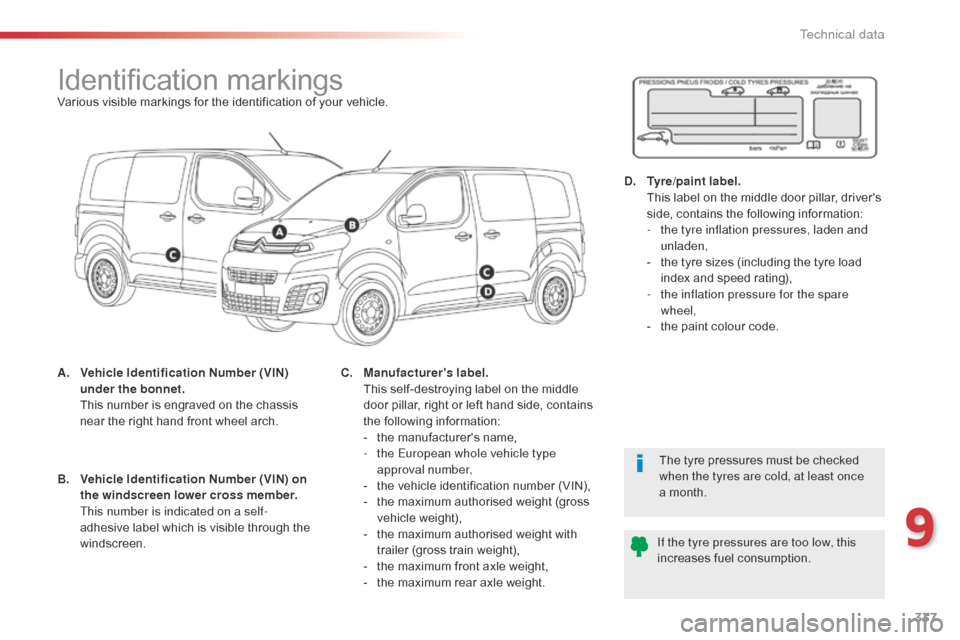
337
Jumpy _en_Chap09_caracteristiques-techniques_ed01-2016
Identification markingsVarious visible markings for the identification of your vehicle.
A.
V
ehicle Identification Number (VIN)
under the bonnet.
T
his number is engraved on the chassis
near the right hand front wheel arch.
The tyre pressures must be checked
when the tyres are cold, at least once
a month.
If the tyre pressures are too low, this
increases fuel consumption.
B.
V
ehicle Identification Number (VIN) on
the windscreen lower cross member.
T
his number is indicated on a self-
adhesive label which is visible through the
windscreen. C.
M
anufacturer's label.
T
his self-destroying label on the middle
door pillar, right or left hand side, contains
the following information:
-
t
he manufacturer's name,
-
t
he European whole vehicle type
approval number,
-
t
he vehicle identification number (VIN),
-
t
he maximum authorised weight (gross
vehicle weight),
-
t
he maximum authorised weight with
trailer (gross train weight),
-
t
he maximum front axle weight,
-
t
he maximum rear axle weight.D.
T
yre/paint label.
T
his label on the middle door pillar, driver's
side, contains the following information:
-
t
he tyre inflation pressures, laden and
unladen,
-
t
he tyre sizes (including the tyre load
index and speed rating),
-
t
he inflation pressure for the spare
wheel,
-
t
he paint colour code.
9
Technical data
Page 340 of 595

338
Jumpy_en_Chap10a_BTA_ed01-2016
Emergency or assistance call
If an impact is detected by the airbag
control unit, and independently of
the deployment of any airbags, an
emergency call is made automatically.
Localised Emergency Call
In an emergency, press this
button for more than 2 seconds.
Flashing of the green indicator
lamp and a voice message
confirm that the call has
been made to the "Localised
Emergency Call"* centre.
Pressing this button again immediately cancels
the call.
The green indicator lamp goes off.
At any time, pressing this button for more than
8 seconds cancels the call.
The green indicator lamp remains on (without
flashing) when communication is established.
It goes off at the end of the call.
This call is dealt with by the "Localised
Emergency Call" centre, which receives
locating information from the vehicle and
can send a detailed alert to the appropriate
emergency services.
In countries in which a centre is not
operational, or when the locating service
has been expressly declined, the call is dealt
with directly by the emergency services (112)
without the vehicle location. *
T
hese services are subject to conditions and
availability.
C
onsult a CITROËN dealer.If you benefit from the C
ITROËN
C
onnect Box offer with the SOS and
assistance pack included, there are
additional services available to you in
your MyCITROËN personal space, via
the Internet website for your country.
Audio and Telematics